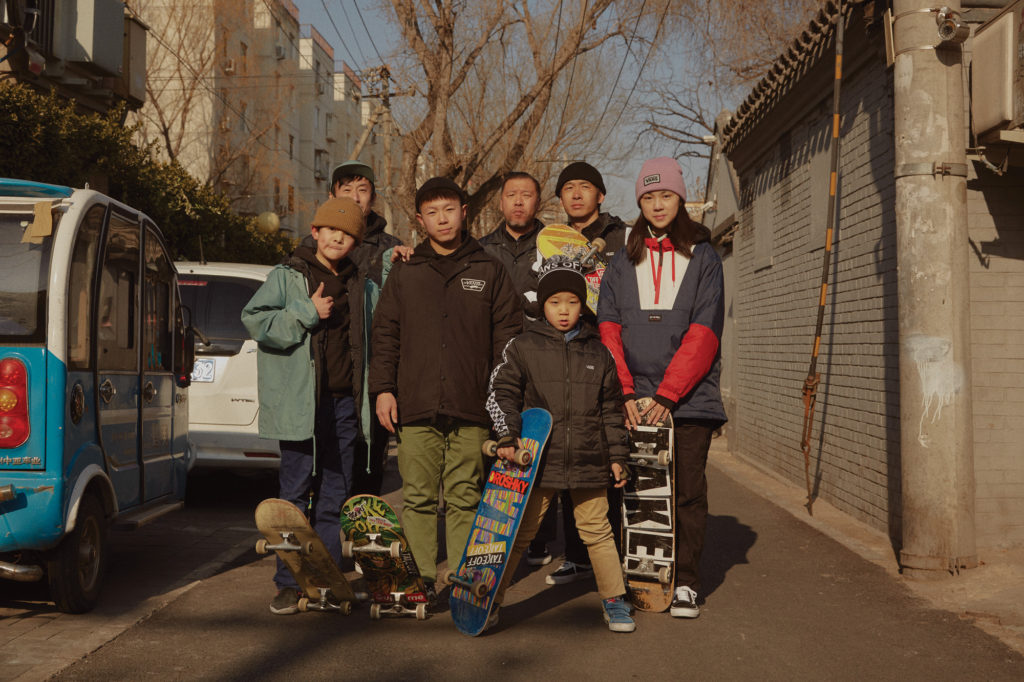
Through hard times and good, brands that cultivate meaningful relationships with key stakeholders survive and thrive. That’s the case with youth culture mainstay, Vans.
In 1966, Paul Van Doren started selling vulcanized rubber-soled deck shoes with canvas tops out of a small shop in front of his factory in Anaheim, California. Paul began distributing his deck shoe, known to this day as the “Authentic,” at an affordable price to locally owned retailers in the SoCal region.
It wasn’t until 1974, when a group of salt and sand loving misfits from Santa Monica, California, adopted the shoe, that the business “found its first cultural connection,” Doug Palladini, Global Brand President of Vans, tells We First.
“These were kids who surfed every day. When the waves were flat, they wanted something else to do. So, they tried to mimic what they were doing in the water, on their skateboards, on concrete.”
Legend has it that these culture carvers favored a beach known as Dogtown and skated for the Zephyr surf shop. The team, revered as the Z boys, liked Authentics, “because of the vulcanized rubber bottom. It gripped the board really well, but they could still feel it underneath their feet, which is important for skateboarding,” Palladini explains.
From its humble beginnings, Vans has grown into a global trend setter, making cultural connections with myriad cohorts across 90 countries generating over $4 billion in annual sales.
So, how did they do it? How do they connect with different audiences in an authentic way that continues to build their brand after more than 50 years?
Cultural pillars of purpose:
To foster a community that goes beyond transactional interactions, Vans looks to its higher purpose. “Creative self expression is such a powerful part of who we are as human beings,” says the Global Brand President. “Our purpose is to enable that for people all over the world.”
By maintaining a structure to how Vans exhibits its purpose, the business has maintained authenticity and credibility. “We look at creative self expression through the lens of four filters: art, music, action sports and street culture,” Palladini says. “That’s enabled us to stay focused and true to ourselves as we’ve grown.”
Many companies make the mistake of trying to hijack popular culture. Vans’ strategy has been to invest in localized communities that have helped the brand position itself as genuine. The shoe company is transparent about what it stands for. That has fostered “organic cohorts coming to us,” Palladini says. “We are open to anyone but not for everyone.”
“It doesn’t matter where you come from, what language you speak, what color you are or who you love. It’s all good to us. There may come a time when you decide that Vans isn’t the right brand for you. And we’re okay with that because ubiquity is not our objective.”
How Vans connects with youth culture and old timers alike:
It’s hard enough connecting deeply with one age group but Vans’ looks to engage with consumers of all ages. Today’s digitally centered youth are often distrustful of marketing. How can a company so large with such a wide target demographic gain consumer goodwill?
“We believe that ‘Off The Wall’ is a state of mind,” Palladini says of Vans’ long standing tagline. “It’s a way you approach what you do with yourself during these 700,000 hours of life that we have. That ties our group together, regardless of age. We get a lot of intel by listening to our fans and communicating back and forth.”
Essentially, the ‘Off The Wall’ mentality allows Vans to reframe its products to different interest and demographic areas. While the shoe and apparel giant still does Metallica collaborations, it also joins forces with small streetwear brands and social influencers.
That said, Vans is selective about its paid sponsors. Celebrity or influencer ambassadors have to prove a sincere affinity for the brand. “That organic connection is what’s paramount. It spills over into the way that we tell stories,” Palladini says. “Vans is more of a documentary than a drama.”
Other examples of how Vans connects with youth are through initiatives like the Simpsons partnership and Checkerboard Day. “It’s all about lifting up that creative self expression that is at the center of humanity,” Palladini explains.

While data-driven insights influence brand strategy, companies must listen. “A lot of us have aged out of youth culture a long time ago,” the seasoned surfer says. “Give voice to the up and coming people in your organization, not just the executive team. Then give voice to your audience and listen to them. Go out into the world and see it for yourself.”
Before COVID-19 you might catch Palladini chatting in the surf line up, going to concerts or participating in street culture events. Today, he and his team pay close attention to what fans are expressing virtually on social media.
“We’re trying to be a part of the world we want to represent,” Doug says. “You can’t hire a third party agency to tell you what’s cool with Group X while you sit at your desk and answer emails. You need to go see it yourself.”
That understanding and connection also informs Vans’ digital and social media initiatives. “The depth of engagement per fan is more important than the number of fans. We want to connect with people inspired by creative self-expression.”
Stakeholder engagement during COVID-19:
Vans’ commitment to fostering meaningful relationships has shown through during the pandemic. “Paul Van Doren has this famous quote that we use. He said, ‘Vans isn’t a footwear and apparel company. Vans is a people company that makes footwear and apparel.’”
- Taking care of Employees: When the hard times hit, Vans looked to its founder’s words and put people first. “We had to make sure our employees were okay,” Palladini says. “I think the best solution to support your employees right now is to be flexible.” The shoemaker offers team members in its Costa Mesa office the ability to work from anywhere and if someone has to miss a meeting for personal reasons, they will record it.
- Connecting with consumers: After taking care of its internal community, Vans reached out to its fans. “We had to let them know that we care about you, even if you’re not buying from us right now and let’s work together to get through this thing.”
To connect with consumers, Vans put “150% into the digital realm,” to provide them with welcome distractions from pandemic challenges while in quarantine. They launched engagement campaigns like Bouncing Off The Walls, a content series of 60 second action sports clips to wash your hands to.
Another notable initiative is The Shoe Box Challenge. Vans invited consumers to take an old Vans shoebox, transform it into something artistic and share it online with the hashtag #VansShoeBoxChallenge. Select winners received a code to customize a pair of vans for free.
“People spent a week creating these massive diagrams. I saw airplanes flying around, working clocks, it was incredible what people came up with.” Palladini says. “Arby’s, the fast food chain, jumped in with their own version.”
By building community around creative expression, Vans is able to act on purpose and deepen ties with its target audience.
- Supporting retail partners: While looking out for employees and consumers is commendable, perhaps the most outstanding assistance Vans has offered during the coronavirus is to its retail customers.
“We come from the best board sports shops, music venues and art galleries in the world. These are our extended family. They’re cultural epicenters. They run on passion, not cashflow,” Palladini says.

Vans launched the Foot The Bill initiative to help small businesses in these challenging times. By utilizing its customization platform they invited grassroots partners to collaborate with local artists to make limited edition shoes. Vans then donates the proceeds to the store. “The best part about it was the local communities that came alive to support the stores,” recounts the Global Brand President.
By supporting grassroots partners that make its business possible, Vans is also able to focus on its product so that it can keep business alive.
Black Lives Matter:
In addition to its commendable leadership following the onset of COVID-19, Vans demonstrated its commitment to purpose and community in the face of the Black Lives Matter movement.
To illustrate its solidarity, the shoemaker posted support on social media. Vans also donated $100,000 to NAACP, $50,000 to GSA Network and $50,000 to Color Of Change.
“We believe that Black Lives Matter. If you don’t, we respect that you have your own point of view but we don’t agree with it. Vans might not be the best brand for you,” Palladini articulates.
By listening and taking action the company is showing up for what matters. That said, Vans admittedly has internal work to do to further its anti-racisist stance. “We have not been where we need to be in terms of diversity.” Doug reflects. “We have to be honest with ourselves and take a sober look at what we are committing to internally and externally.”
Striving for sustainability:
While Vans doesn’t put sustainability at the forefront of its marketing initiatives, they are taking steps to be more environmentally friendly.
“When we do talk about sustainability, it comes through the lens of our four pillars,” Palladini explains. “A great example is our long lasting partnership with the Surfrider Foundation. That’s about keeping the oceans safe and clean so that we can continue to use those natural resources of wave energy to do what we want to do with surfing.”
With the direction of its parent company, VF Corporation, Vans also publishes science-based targets to reduce its environmental footprint. The brand is also seeking greener alternatives to vulcanized rubber, which is a core ingredient in many of its shoes.
The road ahead:
Times change, styles change but purpose stays consistent, “The number one attribute for ongoing success for us is around listening and acting,” Palladini shares.
You don’t have to know all of the answers. “The adjective I use to describe the Vans brand is imperfect,” he says. “We’re like a beaten up pair of Authentics. They’ve been well loved with holes in the toe and some of the rubber is starting to come off. We’re a part of your life. A lot of the fun things happen with Vans on your feet, but you get holes in them.”
By embracing imperfection and celebrating creativity, Vans is able to connect with people on a human to human level, even as it continues to scale globally. “We want to remain hungry and humble as an imperfect brand,” Palladini says.

